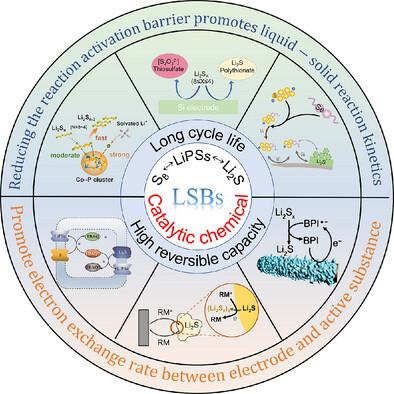The Catalytic Chemistry for High-Performance Lithium-Sulfur Batteries: A Review and Prospects
IF 19
1区 材料科学
Q1 CHEMISTRY, MULTIDISCIPLINARY
引用次数: 0
Abstract
Lithium-sulfur (Li─S) batteries offer exceptionally high theoretical energy density, making them strong candidates for next-generation energy storage. However, their practical implementation is hindered by severe polysulfide shuttling and sluggish solid-liquid-solid phase transitions, which considerably diminish cycling stability and capacity retention, especially at elevated sulfur loading (≥5 mg cm−2). Recent advancements highlight the crucial importance of catalytic chemistry in overcoming these obstacles by reducing reaction energy barriers, facilitating long-range electron transport, and overall performance. Despite progress, a deeper mechanistic understanding of catalytic chemical mediation remains lacking. This review explores catalytic chemistry processes in Li─S batteries, particularly those that promote liquid-solid conversion and long-range electron transport. It discusses key approaches, such as the adjustment of adsorption/desorption dynamics, the regulation of solid-phase nucleation and breakdown energy barriers, and the facilitation of alternate polysulfide conversion routes. Additionally, recent insights from in situ characterization and computational modeling that uncover the molecular-level mechanisms behind catalytic enhancement are highlighted. Future efforts should integrate catalytic materials with advanced electrode architectures and develop multifunctional catalysts to enable high-loading, high-performance Li─S batteries suitable for practical deployment.

高性能锂硫电池的催化化学研究进展与展望
锂硫(Li─S)电池提供了极高的理论能量密度,使其成为下一代储能系统的有力候选者。然而,它们的实际实施受到严重的多硫穿梭和缓慢的固-液-固相变的阻碍,这大大降低了循环稳定性和容量保持,特别是在高硫负荷(≥5 mg cm−2)时。最近的进展强调了催化化学通过减少反应能量障碍、促进远程电子传递和整体性能来克服这些障碍的关键重要性。尽管取得了进展,但对催化化学调解的更深层次的机制理解仍然缺乏。本文综述了Li─S电池的催化化学过程,特别是那些促进液固转换和远程电子传递的化学过程。它讨论了关键的方法,如吸附/解吸动力学的调节,固相成核和击穿能垒的调节,以及多硫化物交替转化路线的促进。此外,本文还强调了原位表征和计算建模的最新见解,揭示了催化增强背后的分子水平机制。未来的努力应该将催化材料与先进的电极结构结合起来,开发多功能催化剂,使高负载、高性能的锂离子电池适合实际部署。
本文章由计算机程序翻译,如有差异,请以英文原文为准。
求助全文
约1分钟内获得全文
求助全文
来源期刊

Advanced Functional Materials
工程技术-材料科学:综合
CiteScore
29.50
自引率
4.20%
发文量
2086
审稿时长
2.1 months
期刊介绍:
Firmly established as a top-tier materials science journal, Advanced Functional Materials reports breakthrough research in all aspects of materials science, including nanotechnology, chemistry, physics, and biology every week.
Advanced Functional Materials is known for its rapid and fair peer review, quality content, and high impact, making it the first choice of the international materials science community.
 求助内容:
求助内容: 应助结果提醒方式:
应助结果提醒方式:


